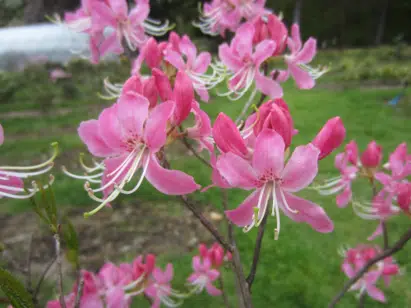Size
Large

Looking for something in particular? Click here to search.


Coreopsis tripteris ‘Gold Standard’
Coreopsis tripteris ‘Gold Standard’ (tall tickseed)
Although a shorter version of the straight species, at nearly 6 feet tall, ‘Gold Standard’ is still a large and lofty plant with strong stems and upright blue-green foliage that yield a bounty of bright... more

Rhododendron vaseyi ‘Spring Spangle’
Deciduous azalea ‘Spring Spangle’
This is a deciduous azalea that produces clusters of pink flowers in mid-spring and has wonderful red-purple fall color. Can take sun or shade. An excellent azalea for our area. Only... more

Rhododendron ‘Bowie’
Lepidote rhododendron
'Bowie’, pronounced like “buoy”, is an intraspecific hybrid, scaly-leaved rhododendron, meaning it is the result of crossing the Appalachian native Rhododendron minus with the Florida Panhandle endemic Rhododendron minus var. chapmanii. Flip the leaves over and you’ll see tiny scales across the surface. A good... more

Rhododendron austrinum
Deciduous azalea
Rhododendron austrinum, the Florida flame azalea, is a deciduous azalea that produces clusters of yellow to orange, sweetly fragrant flowers in May. Though native to the Florida Panhandle, southern Alabama, and southeastern Mississippi, Rhododendron austrinum has proven... more

Dryopteris goldiana
Goldie’s wood fern
A deciduous fern, Goldie’s wood fern occurs in moist, rich soil in cool woods. Reaching a height of 3-5 feet, it is one of the largest Dryopteris in Ohio. The spores occur on the... more

Syringa vulgaris
Common lilac
Native to the Balkans in southeastern Europe, Syringa vulgaris (common lilac) is a member of the olive family (Oleaceae), which also includes Fraxinus (ash), Chionanthus (fringe tree), Ligustrum (privet), and... more

Fothergilla
Fothergilla
Fothergilla is a charming shrub native to the southeastern United States. The name of the genus, which has also become the common name, honors John Fothergill (1712-1780), a Quaker physician... more

Evergreen azalea
Rhododendron ‘Hino-Red’ is named after a city near Tokyo. It is classified in the Kurume group of evergreen azaleas, which in Northeast Ohio are semi-evergreen. These azaleas perform best in... more

Hydrangea quercifolia
Oakleaf hydrangea
This outstanding shrub is native to the southeastern U.S. where it inhabits moist wooded slopes, ravines, and the banks of streams. Hydrangea quercifolia is one of two hydrangeas native to... more


Vaccinium corymbosum
Highbush blueberry
Blueberries are members of the heath family (Ericaceae). Vaccinium corymbosum has significant value for wildlife and for enhancement of our landscape. Its rhododendron and azalea cousins may have very showy... more

Rudbeckia maxima
Great coneflower
Peganum from Henfield, England, CC BY-SA 2.0 <https://creativecommons.org/licenses/by-sa/2.0>, via Wikimedia Commons more

Rhus typhina ‘Tiger Eyes’
Staghorn sumac
Photo by and (c)2006 Derek Ramsey (Ram-Man). Location credit to the Chanticleer Garden., CC BY-SA 3.0 <http://creativecommons.org/licenses/by-sa/3.0/>, via Wikimedia Commons more

Physocarpus opulifolius
Eastern ninebark
Eastern ninebark is easily grown in average, well-drained soil in full sun to part shade. It is an upright, somewhat coarse, deciduous shrub noted for its exfoliating bark which peels in... more

Passiflora incarnata
Passionflower
This species is one of 300+ within the genus and most are tropical, luckily this one is native to Ohio. Passionflower prefer sun and average garden soil. Although they are late to emerge in... more






Cornus sericea ‘Ruby’
Red-osier dogwood
This cultivar was introduced in 1988 and was selected for its layering habit, bright red stems and uniform rounded form. Red stems provide some much need color in a snow-covered winter landscape. Small white flowers appear in the... more






